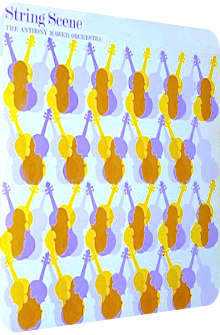
Anthony Mawer
String Scene
1969
String Scene by British composer and arranger Anthony Mawer (1930–1999) is a twelve-track album of library music. There, I’ve said it, time to move on. But this is a particularly interesting work for reasons concerning the composer. Released in 1969 on the Southern Library Of Recorded Music, it is created during a time where Mawer, a library music veteran, breaks the long-lasting bonds with the DeWolfe Music label aka the company with the biggest archive of library music, stocking more than 80,000 compositions… and counting! Once library music made Mawer a rich man, he creates his own label (with access to a studio) called Peer International Library Limited.
String Scene is thus reissued in 1970 on this very label which Mawer co-ran with Dennis Berry. Close friend Peter Dennis is also involved. This gentleman might be known to Exotica connoisseurs for his involvement in the Roger Roger Ensemble’s Afro, Spooky (1974) which, you’ve guessed it, is an album full of library music. But back to String Scene. The title says it all… but then it says anything at all. Sure, vivacious strings are on board, but flutes, bass guitars, pianos and mallet instruments carve out the already blooming melodies. Side A features material exclusively written by Mawer, but it is side B that captures the imagination: three additional composers are on board, among them Mr. Dennis. Their vision of a string-fueled track differs greatly. The eternal spring themes of Mawer are at times mercilessly neglected. Why this album is good enough to be considered here and why this, in the end, does not matter at all will be carved out in a non-pessimistic way over the course of this review.
String Scene is the eponymous opener and immediately unleashes the technicolor paint pots with additional buckets of good mood. The string side is of course well-manned and allows to inject huge washes of euphonious melodies, but the instruments unrelated to the strings are the real stars here, for they boost the violins’ majesty. Green-bluish vibraphone splotches, a three-note bass guitar melody, plinking castanets plus glockenspiel-accompanied flute tones as well as an unnecessarily Balearic guitar sequence hint at a large orchestra. The High Andes is better used in opening credit of a rural TV series; the strings are indeed mountainous, the crunchy rhythm guitar shimmers in golden tones, the melody is utterly hummable due to its faux-grandiloquence and the vitreous harpsichord adds a Gothic counterpart to the embracing scenery, but exotic this tune is not, nor is the following Guitars & Lovers, although this piece at least glows in those typically besotted colors. Flute tones, glockenspiels and yearning strings make this a chintzy crystal.
Whereas Pop Alive imposes pizzicato strings on the listener for the first time but otherwise succeeds mightily due to the strong melodies, an encore of the glassy harpsichord and joyous piano chords as well as the prominently cheeky bass guitar slaps, it is Prima Bossa Nova which succeeds only occasionally as it uses the strings in a downright enchanting fashion; this tonality is used way too sparsely. What works well, though, is the enchanting flute melody, and once it conflates with the strings, one could swear this composition has been used in a big budget love film. Naturally, by the rules of library music, it has not. Side A closes with the wondrous Wanderlust, a feeling every Exotica listener is aware of when listening to travelog albums. Here, the mixture between mauve-tinted strings and the lead piano truly works. Everything is warm on this piece, whether it is the guitars or even the glockenspiels.
Side B does not suffer at all, as it might even be the more interesting tidbit for listeners due to the roster of skillful composers, all of them regular library musicians. However, the first two tunes are written by Anthony Mawer as well: Rainbow Magic enchants with pre-funky guitar splinters, another dose of that three-note bass guitar undulation and truly warm string washes that live up to the Space-Age era. It is the 6/8 rhythm and glorification of Felice, however, that lets the strings gleam in all colors of the rainbow and proposes a translucent glow of the scenery. The bass guitar is definitely unfitting here, but is swallowed by the magnitude of the strings anyway. This one mimics Les Baxter's kind of approach. Added flute tones ameliorate the composition further. Stuart Crombie‘s The Hawks is next, a histrionic piece for a drama or thriller. Horror strings swirl in blood-red colors, everything feels heavy and mournful, there is anything picturesque on this cinematic piece. Library music aficionado Peter Dennis’ Latino follows, a flowery piece of greenery where the four-note bursts of the vivacious strings function as the leitmotif. Classic drums, genteel pianos, aeriform flutes and glistening guitar licks round off the personification of Easy Listening.
Chris Gunning’s Nordic March then paints a stupefyingly dreamlike winter landscape in front of the listener’s inner eye. Quavering strings back their floating brethren, it is as if one watches a tramontane aurora. Tumular pizzicato strings round the string-centric infusion off; Gunning has delivered a piece that truly lives up to the album title. And he makes sure the orchestra uses a double bass rather than a bass guitar. The finale is delivered by Frank Sterling and his Blue Tune which celebrates the glorious return of the bass guitar and its abyssal formations. This 3/4 piece depicts a shady twilight with haunting flute shards, dubious strings and that gorgeously warped glissando on the strings that is so archetypical for Space-Age. Succeeding more with its textures than the melodies themselves, Blue Note is a great endpoint.
I have to admit that an album title such as String Scene does not wake my interest, so if I had not inherited this LP, chances are that I never would have witnessed its existence. This album, despite being loaded with library music, is still more important than one might think, if only for personal reasons concerning Anthony Mawer. He was still a library musician back in 1969, but had the guts to move one crucial step forward by creating his own studio with the money he earned from his affiliation with DeWolfe Music. Not only is the presentation flawless, Mawer invites like-minded spirits to appear on this LP as well. And these gentlemen make it worth anyone’s while. Even though Mawer’s own material is good enough, with the superbly shiny Wanderlust, Rainbow Magic and Felice being the cream of the crop harmony-wise, it is the other composers who break the endemic style and offer a different viewpoint.
It is exactly here where Chris Gunning and his Nordic March comes into play: what a majestic composition this is! While it does not feature anything else than strings – a good choice, given the album title and overall concept – it comprises more textures than one might imagine. The icy, hibernal landscape is a dream, not necessarily exotic, but all the more gyrating around Space-Age realms. As with all of Anthony Mawer’s albums, the music is skillfully orchestrated, but depends on the listener’s cooperation. Is listening to library music really fun, given the flood of releases and the fact that it is produced to be used in creative projects? I cannot give the definite answer. I just know that this release is a good one, with a few very stellar tracks that break the spell of mediocrity.
Exotica Review 362: Anthony Mawer – String Scene (1969). Originally published on Jul. 26, 2014 at AmbientExotica.com.
